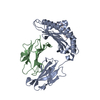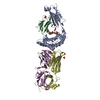[English] 日本語
 Yorodumi
Yorodumi- PDB-7na5: Structure of the H2DB-TCR ternary complex with HSF2 melanoma neoa... -
+ Open data
Open data
- Basic information
Basic information
| Entry | Database: PDB / ID: 7na5 | ||||||
|---|---|---|---|---|---|---|---|
| Title | Structure of the H2DB-TCR ternary complex with HSF2 melanoma neoantigen | ||||||
 Components Components |
| ||||||
 Keywords Keywords | IMMUNE SYSTEM / neoantigen / cancer / melanoma / B16 / mouse / H2DB / TCR / TCR-MHC complex / anchor residue mutation / HSF2 | ||||||
| Function / homology |  Function and homology information Function and homology informationRNA polymerase II intronic transcription regulatory region sequence-specific DNA binding / antigen processing and presentation of endogenous peptide antigen via MHC class I via ER pathway, TAP-dependent / negative regulation of receptor binding / early endosome lumen / Nef mediated downregulation of MHC class I complex cell surface expression / DAP12 interactions / transferrin transport / cellular response to iron ion / lumenal side of endoplasmic reticulum membrane / Endosomal/Vacuolar pathway ...RNA polymerase II intronic transcription regulatory region sequence-specific DNA binding / antigen processing and presentation of endogenous peptide antigen via MHC class I via ER pathway, TAP-dependent / negative regulation of receptor binding / early endosome lumen / Nef mediated downregulation of MHC class I complex cell surface expression / DAP12 interactions / transferrin transport / cellular response to iron ion / lumenal side of endoplasmic reticulum membrane / Endosomal/Vacuolar pathway / Antigen Presentation: Folding, assembly and peptide loading of class I MHC / peptide antigen assembly with MHC class II protein complex / antigen processing and presentation of exogenous protein antigen via MHC class Ib, TAP-dependent / cellular response to iron(III) ion / MHC class II protein complex / negative regulation of forebrain neuron differentiation / ER to Golgi transport vesicle membrane / peptide antigen assembly with MHC class I protein complex / regulation of erythrocyte differentiation / regulation of iron ion transport / response to molecule of bacterial origin / MHC class I peptide loading complex / HFE-transferrin receptor complex / T cell mediated cytotoxicity / antigen processing and presentation of endogenous peptide antigen via MHC class I / positive regulation of T cell cytokine production / antigen processing and presentation of exogenous peptide antigen via MHC class II / positive regulation of immune response / MHC class I protein complex / positive regulation of T cell activation / peptide antigen binding / positive regulation of receptor-mediated endocytosis / negative regulation of neurogenesis / positive regulation of T cell mediated cytotoxicity / cellular response to nicotine / multicellular organismal-level iron ion homeostasis / Modulation by Mtb of host immune system / specific granule lumen / phagocytic vesicle membrane / recycling endosome membrane / Immunoregulatory interactions between a Lymphoid and a non-Lymphoid cell / Interferon gamma signaling / negative regulation of epithelial cell proliferation / MHC class II protein complex binding / late endosome membrane / sensory perception of smell / positive regulation of cellular senescence / tertiary granule lumen / DAP12 signaling / T cell differentiation in thymus / ER-Phagosome pathway / negative regulation of neuron projection development / protein refolding / DNA-binding transcription activator activity, RNA polymerase II-specific / early endosome membrane / spermatogenesis / protein homotetramerization / sequence-specific DNA binding / amyloid fibril formation / intracellular iron ion homeostasis / learning or memory / RNA polymerase II cis-regulatory region sequence-specific DNA binding / Amyloid fiber formation / endoplasmic reticulum lumen / DNA-binding transcription factor activity / Golgi membrane / lysosomal membrane / external side of plasma membrane / focal adhesion / Neutrophil degranulation / regulation of transcription by RNA polymerase II / SARS-CoV-2 activates/modulates innate and adaptive immune responses / structural molecule activity / endoplasmic reticulum / Golgi apparatus / protein homodimerization activity / positive regulation of transcription by RNA polymerase II / extracellular space / DNA binding / extracellular exosome / extracellular region / nucleoplasm / identical protein binding / nucleus / membrane / plasma membrane / cytosol / cytoplasm Similarity search - Function | ||||||
| Biological species |   Homo sapiens (human) Homo sapiens (human) | ||||||
| Method |  X-RAY DIFFRACTION / X-RAY DIFFRACTION /  SYNCHROTRON / SYNCHROTRON /  MOLECULAR REPLACEMENT / Resolution: 2.5 Å MOLECULAR REPLACEMENT / Resolution: 2.5 Å | ||||||
 Authors Authors | Patskovsky, Y. / Finnigan, J. / Patskovska, L. / Newman, J. / Bhardwaj, N. / Krogsgaard, M. | ||||||
| Funding support |  United States, 1items United States, 1items
| ||||||
 Citation Citation |  Journal: To be Published Journal: To be PublishedTitle: Structure of the TCR-H2DB ternary complex with melanoma HSF2 neoantigen YGFRNVVHI Authors: Patskovsky, Y. / Finnigan, J. / Patskovska, L. / Newman, J. / Bhardwaj, N. / Krogsgaard, M. | ||||||
| History |
|
- Structure visualization
Structure visualization
| Structure viewer | Molecule:  Molmil Molmil Jmol/JSmol Jmol/JSmol |
|---|
- Downloads & links
Downloads & links
- Download
Download
| PDBx/mmCIF format |  7na5.cif.gz 7na5.cif.gz | 183.3 KB | Display |  PDBx/mmCIF format PDBx/mmCIF format |
|---|---|---|---|---|
| PDB format |  pdb7na5.ent.gz pdb7na5.ent.gz | 142 KB | Display |  PDB format PDB format |
| PDBx/mmJSON format |  7na5.json.gz 7na5.json.gz | Tree view |  PDBx/mmJSON format PDBx/mmJSON format | |
| Others |  Other downloads Other downloads |
-Validation report
| Summary document |  7na5_validation.pdf.gz 7na5_validation.pdf.gz | 487 KB | Display |  wwPDB validaton report wwPDB validaton report |
|---|---|---|---|---|
| Full document |  7na5_full_validation.pdf.gz 7na5_full_validation.pdf.gz | 494.5 KB | Display | |
| Data in XML |  7na5_validation.xml.gz 7na5_validation.xml.gz | 32.1 KB | Display | |
| Data in CIF |  7na5_validation.cif.gz 7na5_validation.cif.gz | 44.9 KB | Display | |
| Arichive directory |  https://data.pdbj.org/pub/pdb/validation_reports/na/7na5 https://data.pdbj.org/pub/pdb/validation_reports/na/7na5 ftp://data.pdbj.org/pub/pdb/validation_reports/na/7na5 ftp://data.pdbj.org/pub/pdb/validation_reports/na/7na5 | HTTPS FTP |
-Related structure data
| Related structure data |  7n9jS S: Starting model for refinement |
|---|---|
| Similar structure data | Similarity search - Function & homology  F&H Search F&H Search |
- Links
Links
- Assembly
Assembly
| Deposited unit | 
| ||||||||
|---|---|---|---|---|---|---|---|---|---|
| 1 |
| ||||||||
| Unit cell |
|
- Components
Components
-Protein , 4 types, 4 molecules ABDE
| #1: Protein | Mass: 32601.303 Da / Num. of mol.: 1 / Fragment: UNP residues 25-304 Source method: isolated from a genetically manipulated source Source: (gene. exp.)   |
|---|---|
| #2: Protein | Mass: 11879.356 Da / Num. of mol.: 1 / Fragment: UNP residues 21-119 Source method: isolated from a genetically manipulated source Source: (gene. exp.)  Homo sapiens (human) / Gene: B2M, CDABP0092, HDCMA22P / Production host: Homo sapiens (human) / Gene: B2M, CDABP0092, HDCMA22P / Production host:  |
| #4: Protein | Mass: 21426.936 Da / Num. of mol.: 1 Source method: isolated from a genetically manipulated source Source: (gene. exp.)   |
| #5: Protein | Mass: 29788.338 Da / Num. of mol.: 1 Source method: isolated from a genetically manipulated source Source: (gene. exp.)   |
-Protein/peptide , 1 types, 1 molecules C
| #3: Protein/peptide | Mass: 1106.277 Da / Num. of mol.: 1 / Fragment: UNP residues 68-76 / Mutation: K5N / Source method: obtained synthetically / Source: (synth.)  |
|---|
-Non-polymers , 3 types, 225 molecules 




| #6: Chemical | ChemComp-GOL / #7: Chemical | ChemComp-SO4 / #8: Water | ChemComp-HOH / | |
|---|
-Details
| Has ligand of interest | N |
|---|---|
| Has protein modification | Y |
-Experimental details
-Experiment
| Experiment | Method:  X-RAY DIFFRACTION / Number of used crystals: 1 X-RAY DIFFRACTION / Number of used crystals: 1 |
|---|
- Sample preparation
Sample preparation
| Crystal | Density Matthews: 2.61 Å3/Da / Density % sol: 52.98 % / Description: rods |
|---|---|
| Crystal grow | Temperature: 290 K / Method: vapor diffusion, sitting drop / pH: 5.5 Details: 25% PEG3350, 0.1 M Bis-Tris, pH 5.5, 0.2 M lithium sulfate, 15% glycerol |
-Data collection
| Diffraction | Mean temperature: 100 K / Serial crystal experiment: N |
|---|---|
| Diffraction source | Source:  SYNCHROTRON / Site: SYNCHROTRON / Site:  APS APS  / Beamline: 19-BM / Wavelength: 0.9794 Å / Beamline: 19-BM / Wavelength: 0.9794 Å |
| Detector | Type: ADSC QUANTUM 210r / Detector: CCD / Date: Dec 9, 2020 / Details: SI 111 CRYSTAL |
| Radiation | Monochromator: Si(111) / Protocol: SINGLE WAVELENGTH / Monochromatic (M) / Laue (L): M / Scattering type: x-ray |
| Radiation wavelength | Wavelength: 0.9794 Å / Relative weight: 1 |
| Reflection | Resolution: 2.5→50.01 Å / Num. obs: 35345 / % possible obs: 99.4 % / Observed criterion σ(I): 0 / Redundancy: 5.9 % / CC1/2: 0.987 / Rmerge(I) obs: 0.161 / Net I/σ(I): 7.8 |
| Reflection shell | Resolution: 2.5→2.6 Å / Redundancy: 4.5 % / Mean I/σ(I) obs: 1.3 / Num. unique obs: 3783 / CC1/2: 0.45 / % possible all: 95.8 |
- Processing
Processing
| Software |
| ||||||||||||||||||||||||||||||||||||||||||||||||||||||||||||
|---|---|---|---|---|---|---|---|---|---|---|---|---|---|---|---|---|---|---|---|---|---|---|---|---|---|---|---|---|---|---|---|---|---|---|---|---|---|---|---|---|---|---|---|---|---|---|---|---|---|---|---|---|---|---|---|---|---|---|---|---|---|
| Refinement | Method to determine structure:  MOLECULAR REPLACEMENT MOLECULAR REPLACEMENTStarting model: PDB entry 7N9J Resolution: 2.5→50.01 Å / Cor.coef. Fo:Fc: 0.952 / Cor.coef. Fo:Fc free: 0.919 / SU B: 11.616 / SU ML: 0.242 / Cross valid method: THROUGHOUT / σ(F): 0 / ESU R: 0.441 / ESU R Free: 0.278 / Stereochemistry target values: MAXIMUM LIKELIHOOD Details: HYDROGENS HAVE BEEN ADDED IN THE RIDING POSITIONS U VALUES : REFINED INDIVIDUALLY
| ||||||||||||||||||||||||||||||||||||||||||||||||||||||||||||
| Solvent computation | Ion probe radii: 0.5 Å / Shrinkage radii: 0.5 Å / VDW probe radii: 0.8 Å / Solvent model: MASK | ||||||||||||||||||||||||||||||||||||||||||||||||||||||||||||
| Displacement parameters | Biso max: 167.09 Å2 / Biso mean: 51.318 Å2 / Biso min: 24.06 Å2
| ||||||||||||||||||||||||||||||||||||||||||||||||||||||||||||
| Refinement step | Cycle: final / Resolution: 2.5→50.01 Å
| ||||||||||||||||||||||||||||||||||||||||||||||||||||||||||||
| Refine LS restraints |
| ||||||||||||||||||||||||||||||||||||||||||||||||||||||||||||
| LS refinement shell | Resolution: 2.5→2.565 Å / Rfactor Rfree error: 0 / Total num. of bins used: 20
|
 Movie
Movie Controller
Controller


 PDBj
PDBj




